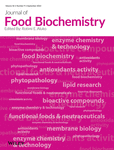Antioxidative, anti-inflammatory, and anticancer properties of the red biopigment extract from Monascus purpureus (MTCC 369)
Abstract
In this study, the Monascus purpureus (MTCC 369) extracted biopigment produced by solid-state fermentation was evaluated for its therapeutic potential using human prostate LNCaP cells. Antioxidant efficacy of the red biopigment determined using 2,2 diphenyl-1-picrylhydrazyl, 2,2′-azino-bis(3-ethylbenzothiazoline-6-sulfonic acid, and ferric reducing antioxidant power assays was found to be 53.16%, 86.27%, and 13.83%, respectively. In addition, expression studies of target gene superoxide dismutase 2 (SOD-2) showed that increasing concentrations (10–50 μg/ml) of the biopigment enhanced its expression from 0.91- to 1.905-fold. An inhibitory effect of 0.424–0.627-fold was observed in the expression of glutathione peroxidase (GPX) with a similar increase in biopigment concentration. Addition of quercetin (positive control) at 50 μg/ml led to 0.295-fold decrease in GPX expression. In contrast, the expression of SOD-2 increased by 1.026-fold in the presence of quercetin. The biopigment also showed an increased serological IL-10 expression (an anti-inflammatory agent) ranging from 1034.58 to 4657.89 pg/ml. Treatment of LNCaP cells with the red biopigment (10–100 μg/ml) resulted in significant (p < .05) reduction (upto 79.86%) in viability and 51.79%–89.86% reduction in cell metabolic activity. Fluorescent microscopy examination of red biopigment-treated cells showed significant inhibition of normal cellular morphology including condensed nuclei, membrane blebbing, and apoptotic bodies, thus confirming its cytotoxic potential. Results of this study revealed that the red biopigment has the potential to modulate the expression of antioxidative and anti-inflammatory markers in addition to being cytotoxic to the LNCaP cancer cells.
Practical applications
These findings indicate that cell treatment with red biopigment has the potential to modulate anti-oxidative, pro-inflammatory and anti-inflammatory genes for therapeutic effects, which is further enhanced by its cytotoxic activity against cancer cells. Considering these cell-based observations, Monascus red biopigment has ample potential as a useful supplement to formulate therapeutic products that delay the development of inflammatory-related diseases and associated complications.
CONFLICT OF INTEREST
All the authors listed above have read and approved the submission. They also declare that they have no competing financial and nonfinancial competing interests.
Open Research
DATA AVAILABILITY STATEMENT
The data that support the findings of this study are available from the corresponding author upon reasonable request. The data are not publicly available due to privacy or ethical restrictions.




